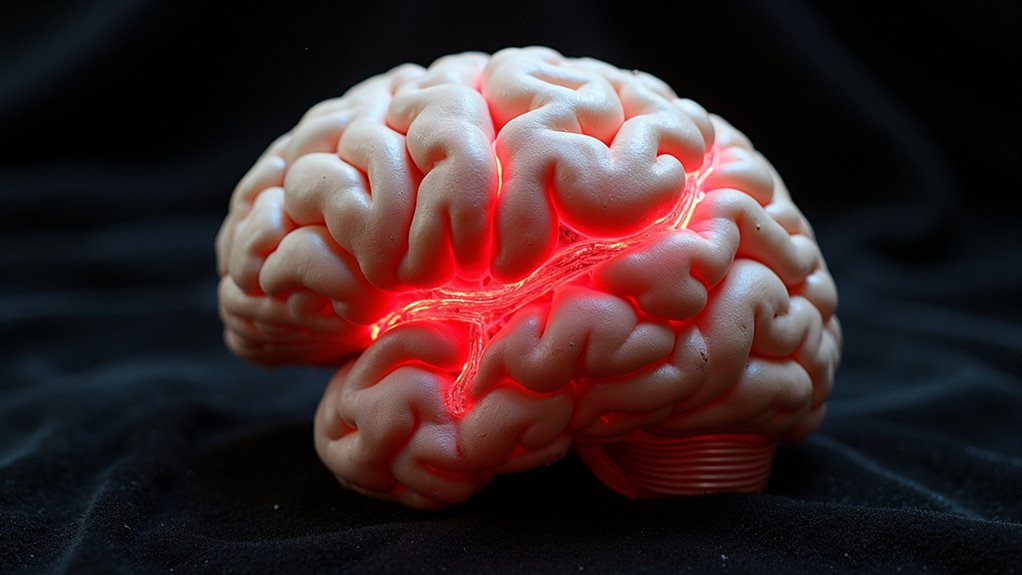Substance addiction ravages your body’s core systems through multiple pathways. Your brain’s reward circuits become hijacked, with dopamine floods 2-10x stronger than natural stimuli. You’ll experience cardiovascular strain, with heart attack risks increasing up to 7x. Your respiratory function deteriorates while your digestive system faces ulceration and bleeding. Your immune system weakens dramatically, leaving you vulnerable to infections. The full scope of addiction’s systemic damage reveals an even more concerning picture.
The Brain’s Battle: Understanding Neural Impact of Substance Abuse

While the brain’s reward system evolved to reinforce survival behaviors, drugs of abuse hijack these neural circuits with unprecedented intensity. Your nucleus accumbens experiences a dopamine flood 2-10 times stronger than natural rewards, fundamentally altering its reward processing capabilities. This disruption triggers widespread functional connectivity changes, particularly affecting your prefrontal cortex‘s ability to regulate impulses and make decisions. Research has shown that D1 medium spiny neurons are specifically activated during drug use, promoting addictive behaviors.
As substance use continues, you’ll experience neuroinflammatory impacts across multiple brain regions. Your hippocampus shrinks, compromising memory formation, while your amygdala becomes hyperactive, intensifying stress responses. The brain’s plasticity mechanisms become corrupted, as drugs alter critical neurotransmitter systems including dopamine, serotonin, and glutamate. Your white matter integrity deteriorates, disrupting essential communication between emotional and cognitive control centers, leading to increasingly compulsive drug-seeking behaviors. However, studies demonstrate that brain recovery patterns can emerge after extended periods of abstinence.
Heart and Blood Vessels Under Siege: Cardiovascular Consequences

Beyond disrupting neural circuits, substance abuse launches a devastating assault on your cardiovascular system, with mortality rates climbing 4% annually despite extensive improvements in heart disease outcomes. Your risk of heart attack soars 7x higher with cocaine, 4.1x with MDMA, and 3.6x with opioids. American Indians and Alaska Natives face the highest mortality rates from substance-related cardiovascular complications.
Acute angina episodes frequently drive emergency department visits, while substances trigger dangerous blood pressure spikes and arrhythmias through sympathetic nervous system activation. Males and working-age adults show particularly elevated risk for these cardiovascular complications.
Long-term vascular pathology develops as chronic use damages your heart’s structure and function. You’ll face impaired ventricular performance, valvular abnormalities, and potential cardiomyopathy. When combined with other substances, especially alcohol, these risks compound drastically. Your likelihood of experiencing fatal cardiovascular events rises to 5.7%, compared to 4.5% in non-users, with effects persisting even after accounting for traditional risk factors.
From Breath to Disease: Respiratory System Damage

Substance abuse triggers a devastating cascade of respiratory complications that can rapidly progress from acute breathing difficulties to life-threatening conditions. You’ll face immediate risks like opioid-induced respiratory depression, which disrupts chronic pain management protocols and often leads to emergency interventions. The social consequences extend beyond individual health, as respiratory failure from drug use strains healthcare resources. Having lung disease dramatically increases the risk of death from opioid overdose compared to those without respiratory conditions.
Chronic tobacco use among substance abusers leads to persistent coughing and permanent lung damage. IV drug use introduces additional hazards through particulate matter and bacterial infections, while immune system suppression leaves you vulnerable to opportunistic lung infections. Whether you’re using depressants, stimulants, or inhalants, each substance carries unique respiratory risks. Long-term exposure results in chronic conditions like COPD, pulmonary fibrosis, and emphysema, particularly when combined with pre-existing lung conditions. These respiratory complications often require intensive medical management and can permanently impact your quality of life.
Digestive Disruption: Gastrointestinal Effects of Drug Use
Drug abuse inflicts severe damage across your entire digestive system, from the esophagus to the intestines, through multiple pathological mechanisms. Each substance causes distinct patterns of injury: opioids disrupt gut motility and trigger opioid induced emesis management challenges, while cocaine’s vasoconstriction leads to ulceration and bleeding.
The complex brain alterations caused by substance dependence influence both physical and psychological aspects of addiction. Damage to the mucous membrane lining of the gastrointestinal tract makes the digestive system more susceptible to infections and ulcers. Alcohol’s carcinogenic effects particularly target your colon and rectum, with beer showing the strongest correlation to cancer development. Synthetic drugs can cause severe hepatic complications and gut microbiome dysregulation, often mimicking inflammatory bowel conditions.
The risks escalate with body packing, where physical trauma from concealed drugs can cause life-threatening intestinal perforation and obstruction. Your digestive system’s complex network of organs becomes increasingly vulnerable to both acute injury and chronic deterioration through continued substance abuse.
The Body’s Defense System: Immune and Organ Deterioration
While your immune system normally serves as a vigilant defender against disease, chronic addiction severely compromises its protective capabilities through multiple pathological mechanisms. Your body’s defense network deteriorates as substances suppress white blood cells and antibody production, leaving you vulnerable to recurring infections. Chronic drug use disrupts the balance of immune cells and their responses.
The effects are particularly severe in your digestive system, where beneficial gut bacteria are destroyed. Chronic drug use triggers widespread inflammation, including inflammation-induced neurodegeneration that impairs cognitive function and decision-making. Your essential organs sustain cumulative damage – your liver struggles with toxin buildup, your heart faces accelerated atherosclerosis, and your kidneys show reduced filtration capacity. These complications often necessitate substance-related organ transplantation in advanced cases.
Furthermore, you’ll face heightened risks of serious infections, including HIV, tuberculosis, and pneumonia, particularly if you’re using intravenous drugs.
Frequently Asked Questions
Can Addiction-Related Brain Damage Be Reversed With Proper Treatment and Abstinence?
Yes, your brain has remarkable neuroplasticity potential that allows for significant recovery from addiction-related damage. Through sustained abstinence and proper treatment, you’ll typically see measurable improvements in brain structure and function within 1-2 years.
While individual recovery timelines vary, research shows that key regions like your prefrontal cortex and reward circuits can heal substantially. However, you’ll need consistent abstinence, as continued substance use disrupts these natural healing processes.
How Long Does It Take for Organ Systems to Recover After Quitting?
Your organ recovery timeline varies by system, but you’ll notice improvements within days of quitting. While withdrawal symptom management is essential in the initial 72 hours, your liver begins regenerating within weeks.
You’ll experience cognitive improvements by 2 weeks, cardiovascular stabilization by 3 months, and immune system restoration within the first year. Full recovery of all systems typically occurs after 12 months of sustained abstinence, though severe damage may require longer healing periods.
Do Prescription Medications Cause the Same Damage as Illegal Drugs?
Both prescription and illegal drugs can cause severe damage, but their effects differ in key ways.
When you misuse prescription medications, you’ll experience specific medication side effects targeting certain body systems, while illegal drugs often cause unpredictable, widespread harm due to varying purity.
Prescription misuse risks include organ damage and addiction, just like illegal drugs, but prescribed medications’ effects are typically more predictable and documented.
You’ll face serious health consequences either way.
What Role Do Genetics Play in Susceptibility to Addiction-Related Health Problems?
Your genetic predisposition plays a significant role in your susceptibility to addiction-related health problems, accounting for 40-50% of addiction risk. You’re more vulnerable if you carry specific variations in genes like DRD2 and OPRM1, which affect your brain’s reward system.
While genetics load the gun, environmental factors pull the trigger your life experiences, stress levels, and exposure to substances interact with these genetic factors to influence your comprehensive addiction risk.
Can Early Intervention Prevent Permanent Damage to Body Systems From Addiction?
Early intervention strategies can markedly prevent lasting damage to your body systems if you’re struggling with addiction. When you receive prompt treatment, you’ll minimize exposure to toxic substances before they cause irreversible organ damage.
Treatment efficacy assessment shows that early intervention helps preserve your brain’s neuroplasticity, protects integral organs, and maintains immune function. You’ll have better outcomes when treatment begins before substances trigger permanent cellular degeneration or systemic complications.

